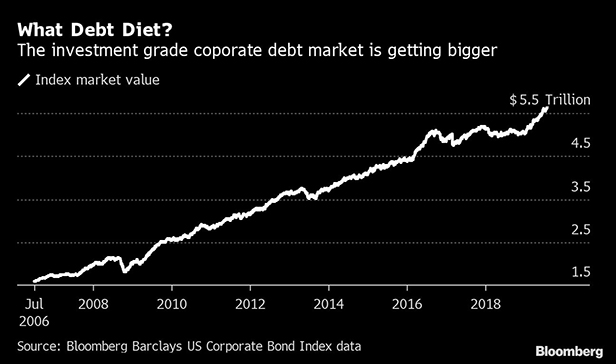The great deleveraging that was supposed to sweepover corporate America is dead. Or, at least, on hold.
|Blue-chip companies have begun to ramp up borrowing again as central banksglobally flood economies with money. Liabilities have reached theirhighest level relative to income since 2009, according to MorganStanley's analysis of second-quarter data. As of last Thursday, thenumber of companies selling investment-grade debt in September hadsurged 63 percent from the same period last year.
|It wasn't supposed to be this way. Last year and at thebeginning of 2019, corporations ranging from Verizon CommunicationsInc. to Tupperware Brands Corp. talked about their goals to cutdebt levels. Companies were under pressure from both stock and bondinvestors who worried about borrowers' liabilities. Around 40percent of investment-grade companies now have obligations that aremore consistent with junk ratings, according to Morgan Stanley.(Credit rating agencies use multiple factors beyond leverage toassess a company's debt rating.)
|
For many companies, debt levels are now creeping higher, eitherby choice or involuntarily. Revenues are under pressure, andmoney is easy to raise. That temptscorporations to borrow to fund share buybacks and other moves that can boostearnings measures.
|The rising debt burdens that have resulted could make it harderfor corporations to navigate any downturn that may be coming.Companies could find themselves with less cash to pay theirobligations, and refinancing maturing bonds could be more difficultand expensive.
|"You would expect companies, as they sense the economy slowing, to start to prepare themselves to absorb what would likely bean impact to revenue," said Jim Schaeffer, deputy chiefinvestment officer at Aegon Asset Management in Chicago, whichmanages $380 billion of assets. "Instead, they're looking at theincredibly inexpensive cost of debt and taking advantage of that toenhance returns for shareholders."
|Debt levels were growing even before the Federal Reserve startedcutting interest rates in July. The ratio of akey income measure to net debt levels rose to 1.9 times at the endof the second quarter, a record high, according to Morgan Stanleyresearch. The figure was closer to 1.76 times in the same quarterlast year. That ratio was hurt by falling earnings and rising debtloads, as well as declining cash levels, Morgan Stanley strategistsled by Vishwas Patkar wrote last week.
|The falling levels for the key income measure EBITDA (earningsbefore interest, tax, depreciation and amortization) are alsohurting companies' ability to pay interest on their borrowings. Theratio of EBITDA to companies' interest expense, known asthe debt service coverage ratio, has fallen to 10.14 times—thelowest level since 2010, according to Morgan Stanley.
||
Effect on Corporate Financials
The growing leverage levels can be seen in individual companies'results. Tupperware's total debt had climbed to more than $1billion at the end of June, from $889 million at the end of 2018,while its sales and earnings have been falling. The shift wasenough for S&P Global Ratings to cut the company in August tojunk from BBB-, the lowest investment-grade rating.
|Tupperware's lack of sales growth and a financial performancethat isn't meeting its executives' expectations are slowing thepace at which the company will meet its target for debt to EBITDA,said Jane Garrard, vice president of investor relations at theOrlando, Florida-based company.
|Some companies have managed to trim their debt loads. Verizon posted totaldebt of $134.8 billion for the end of the second quarter, down from$135.6 billion in the first quarter. Its borrowings also fellrelative to EBITDA over that period, according to data compiled byBloomberg. Kraft Heinz Co. had cut its total borrowings to $31.8billion as of the end of June, down from $34.2 billion in the sameperiod a year ago.
||
Decade of Debt
Investment-grade companies are selling so much debt becauseinvestors are eager to gain more yield as the Fed cuts rates.September has been one of the busiest months on record, withcorporations having sold more than $150 billion of high-gradebonds. For junk-rated companies, the story is in many casesdifferent, as theriskiest of the risky have struggled to borrow.
|Overall, blue-chip companies' debt loads have been rising formost of the last decade, as they've financed acquisitions, boughtback stock, and taken other moves designed to boost earnings pershare. The total value of U.S. investment-grade corporate bondsstands around $5.8 trillion, a record and more than triple thelevel in October 2008. Companies are hoping they can pay down someof that debt as profits roll in.
|Companies' debt levels may not end up being a huge problem forcorporate bonds, according to Dominique Toublan, head of U.S.credit strategy at BNP Paribas. The borrowers at the bottom end ofthe investment-grade spectrum, those rated in the BBB tier, don'thave much room to borrow more, so debt levels canrise only so much.
|"We don't feel like it's a big headwind for the market. It'smore like the tailwind is slowing down and it's okay," Toublansaid.
||
Investors Complacent?
Companies may believe the economy is doing just fine and there'stime to pay down debt later. Recent indicators suggest that growthmay be better than investors feared earlier this year, which sentthe Bloomberg U.S. Economic Surprise Index to an 11-month high thisweek. And lower bond yields often allow companies to cut theirinterest costs when they refinance debt, which could improvemeasures like debt service coverage ratios.
|But corporate spending is still weak, and economists see agrowing chance of a recession, according to a Bloomberg survey thismonth. Gains from lower interest costs may be offset by fallingearnings. High-yield companies are facing downgrades, relative toupgrades, at the fastest pace since 2009, according toBloomberg data.
|Rising leverage levels may be signaling something important:Companies themselves aren't really performing better now, even iftheir securities are doing well, Morgan Stanley's Patkar said in aninterview.
|"Maybe investors are being complacent about fundamentals alsostarting to improve," Patkar said.
||
Copyright 2019 Bloomberg. All rightsreserved. This material may not be published, broadcast, rewritten,or redistributed.
Complete your profile to continue reading and get FREE access to Treasury & Risk, part of your ALM digital membership.
Your access to unlimited Treasury & Risk content isn’t changing.
Once you are an ALM digital member, you’ll receive:
- Critical Treasury & Risk information including in-depth analysis of treasury and finance best practices, case studies with corporate innovators, informative newsletters, educational webcasts and videos, and resources from industry leaders.
- Exclusive discounts on ALM and Treasury & Risk events.
- Access to other award-winning ALM websites including PropertyCasualty360.com and Law.com.
*May exclude premium content
Already have an account? Sign In
© 2024 ALM Global, LLC, All Rights Reserved. Request academic re-use from www.copyright.com. All other uses, submit a request to [email protected]. For more information visit Asset & Logo Licensing.








